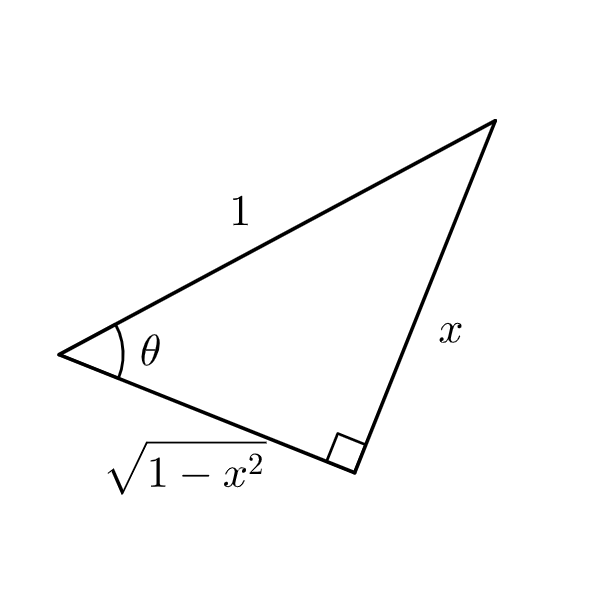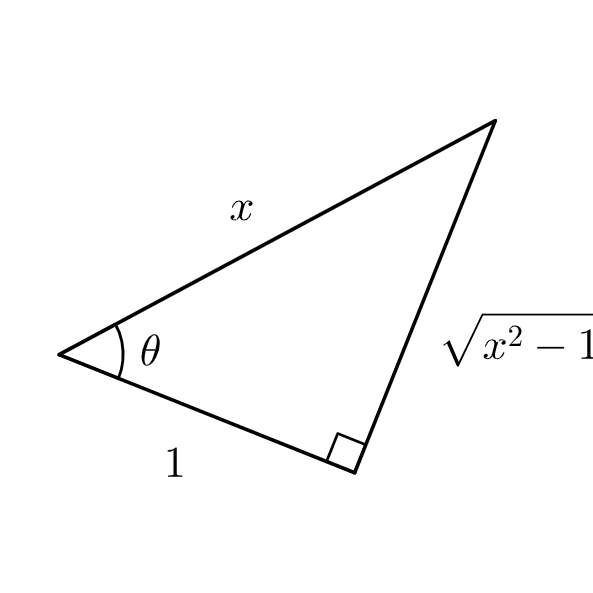Trigonometric substitution is an integration technique that helps solve integrals involving expressions of the form \( a^2x^2 + b^2 \), \( a^2x^2 – b^2 \), and \( b^2 – a^2x^2 \). It transforms the expressions into trigonometric functions, which can be integrated using the techniques covered in my article How to Integrate Products of Trigonometric Functions: Techniques and Tricks. This guide on trigonometric substitution for beginners offers a step-by-step approach to learning trigonometric substitution.
To learn this method visually, please refer to my Trigonometric Substitution Infographic.
Understanding Trigonometric Substitution
Trigonometric substitution is useful for integrals containing expressions of the form:
$$ \sqrt{b^2 – a^2x^2} \Rightarrow x = \frac{b}{a}\sin\theta $$
$$ \sqrt{a^2x^2 + b^2} \Rightarrow x = \frac{b}{a}\tan\theta $$
$$ \sqrt{a^2x^2 – b^2} \Rightarrow x = \frac{b}{a}\sec\theta. $$
Each substitution transforms the integral into a trigonometric integral, allowing us to integrate using trigonometric identities.
How to Solve an Integral Using Trigonometric Substitution
Step 1: Choosing the Proper Trigonometric Substitution
Choose the appropriate substitution based on the expression that appears in the integral.
Step 2: Making the Substitution
Substitute into the integral using the procedure discussed in The Ultimate Step-by-Step Guide to Solving Integrals Using Substitution.
Step 3: Simplifying the Integral
Use trigonometric identities to simplify the integrand as much as possible.
Step 4: Solving the Integral
Integrate the resulting trigonometric integral.
Step 5: Converting Back to x
Use a right triangle to express \( \theta \) in terms of x.
Worked Out Examples
For each case, we will work through an indefinite integral and a definite integral.
Case 1: \( \sqrt{b^2 – a^2x^2} \Rightarrow x = \frac{b}{a}\sin\theta \)
Example 1: Evaluate \( \int \frac{x^2}{\sqrt{1 – x^2}} dx \).
Solution: Let \( x = \sin{\theta} \), then \( dx = \cos{\theta} d\theta \). Substituting into the integral, we get
$$ \int \frac{\sin^2{\theta}}{\sqrt{1 – sin^2{\theta}}}\cos{\theta} d\theta = \int \frac{\sin^2{\theta}}{\sqrt{cos^2{\theta}}}\cos{\theta} d\theta = \int \frac{\sin^2{\theta}}{\cos{\theta}}\cos{\theta} d\theta = \int \sin^2{\theta} d\theta. $$
Applying the power reducing identity gives
$$ \int \frac{1}{2} – \frac{1}{2}\cos{2\theta} d\theta = \frac{1}{2}\theta – \frac{1}{4}\sin{2\theta} + C = \frac{1}{2}\theta – \frac{1}{2}\sin{\theta}\cos{\theta} + C. $$
Using the triangle to convert everything back into terms of x, we arrive at
$$ \frac{1}{2}\arcsin{\theta} – \frac{1}{2}x\sqrt{1 – x^2} + C. $$
Example 2: Evaluate \( \int_0^1 \frac{x^2}{\sqrt{1 – x^2}} dx \).
Solution: Let \( x = \sin{\theta} \), then \( dx = \cos{\theta} ol\theta \). By substituting the limits into the substitution and solving the resulting trigonometric equations, the new limits are \( 0 \Rightarrow 0 \) and \( 1 \Rightarrow \frac{\pi}{2} \). Substituting into the integral, we get
$$ \int_0^{\frac{\pi}{2}} \frac{\sin^2{\theta}}{\sqrt{1 – sin^2{\theta}}}\cos{\theta} d\theta = \int_0^{\frac{\pi}{2}} \frac{\sin^2{\theta}}{\sqrt{cos^2{\theta}}}\cos{\theta} d\theta = \int_0^{\frac{\pi}{2}} \frac{\sin^2{\theta}}{|\cos{\theta}|}\cos{\theta} d\theta = \int_0^{\frac{\pi}{2}} \frac{\sin^2{\theta}}{\cos{\theta}}\cos{\theta} d\theta = \int_0^{\frac{\pi}{2}} \sin^2{\theta} d\theta. $$
Applying the power reducing identity gives
$$ \int_0^{\frac{\pi}{2}} \frac{1}{2} – \frac{1}{2}\cos{2\theta} d\theta = (\frac{1}{2}\theta – \frac{1}{4}\sin{2\theta})|_0^{\frac{\pi}{2}} = \frac{\pi}{4}. $$
Case 2: \( \sqrt{a^2x^2 + b^2} \Rightarrow x = \frac{b}{a}\tan\theta \)
Example 3: Evaluate \( \int \frac{1}{\sqrt{x^2 + 1}} dx \).
Solution: Let \( x = \tan{\theta} \), then \( dx = \sec^2{\theta} d\theta \). Substituting into the integral, we get
$$ \int \frac{1}{\sqrt{tan^2{\theta} + 1}}\sec^2{\theta} d\theta = \int \frac{1}{\sqrt{sec^2{\theta}}}\sec^2{\theta} d\theta = \int \frac{1}{\sec{\theta}}\sec^2{\theta} d\theta = \int \sec{\theta} d\theta = \int \frac{\sec{\theta}(\sec{\theta} + \tan{\theta})}{\sec{\theta} + \tan{\theta}} d\theta = \int \frac{\sec^2{\theta} + \sec{\theta}\tan{\theta}}{\sec{\theta} + \tan{\theta}} d\theta. $$
Let \( u = \sec{\theta} + \tan{\theta} \), then \( du = \sec^2{\theta} + \sec{\theta}\tan{\theta} \). Substituting into the integral, we get
$$ \int \frac{1}{u} du = \ln{|u|} + C = \ln{|\sec{\theta} + \tan{\theta}|} + C. $$
Using the triangle to convert everything back into terms of x, we arrive at
$$ \ln{|x + \sqrt{x^2 + 1}|} + C. $$
Example 4: Evaluate \( \int_0^1 \frac{1}{\sqrt{x^2 + 1}} dx \).
Solution: Let \( x = \tan{\theta} \), then \( dx = \sec^2{\theta} d\theta \). By substituting the limits into the substitution and solving the resulting trigonometric equations, the new limits are \( 0 \Rightarrow 0 \) and \( 1 \Rightarrow \frac{\pi}{4} \). Substituting into the integral, we get
$$ \int_0^{\frac{\pi}{4}} \frac{1}{\sqrt{tan^2{\theta} + 1}}\sec^2{\theta} d\theta = \int_0^{\frac{\pi}{4}} \frac{1}{\sqrt{sec^2{\theta}}}\sec^2{\theta} d\theta = \int_0^{\frac{\pi}{4}} \frac{1}{|\sec{\theta}|}\sec^2{\theta} d\theta = \int_0^{\frac{\pi}{4}} \frac{1}{\sec{\theta}}\sec^2{\theta} d\theta = \int_0^{\frac{\pi}{4}} \sec{\theta} d\theta = \int_0^{\frac{\pi}{4}} \frac{\sec{\theta}(\sec{\theta} + \tan{\theta})}{\sec{\theta} + \tan{\theta}} d\theta = \int_0^{\frac{\pi}{4}} \frac{\sec^2{\theta} + \sec{\theta}\tan{\theta}}{\sec{\theta} + \tan{\theta}} d\theta. $$
Let \( u = \sec{\theta} + \tan{\theta} \), then \( u = \sec^2{\theta} + \sec{\theta}\tan{\theta} \). The new limits are \( 0 \Rightarrow 1 \) and \( \frac{\pi}{4} \Rightarrow 1 + \sqrt{2} \). Substituting into the integral we get
$$ \int_1^{1+ \sqrt{2}} \frac{1}{u} du = \ln{|u|}|_1^{1+ \sqrt{2}} = \ln{(1 + \sqrt{2})}. $$
Case 3: \( \sqrt{a^2x^2 – b^2} \Rightarrow x = \frac{b}{a}\sec\theta \)
Example 5: Evaluate \( \int \frac{1}{\sqrt{x^2 – 1}} dx \).
Solution: Let \( x = \sec{\theta} \), then \( dx = \sec{\theta}\tan{\theta} d\theta \). Substituting into the integral, we get
$$ \int \frac{1}{\sqrt{sec^2{\theta} – 1}}\sec{\theta}\tan{\theta} d\theta = \int \frac{1}{\sqrt{tan^2{\theta}}}\sec{\theta}\tan{\theta} d\theta = \int \frac{1}{\tan{\theta}}\sec{\theta}\tan{\theta} d\theta = \int \sec{\theta} d\theta = \int \frac{\sec{\theta}(\sec{\theta} + \tan{\theta})}{\sec{\theta} + \tan{\theta}} d\theta = \int \frac{\sec^2{\theta} + \sec{\theta}\tan{\theta}}{\sec{\theta} + \tan{\theta}} d\theta. $$
Let \( u = \sec{\theta} + \tan{\theta} \), then \( u = \sec^2{\theta} + \sec{\theta}\tan{\theta} \). Substituting into the integral, we get
$$ \int \frac{1}{u} du = \ln{|u|} + C = \ln{|\sec{\theta} + \tan{\theta}|} + C. $$
Using the triangle to convert everything back into terms of x, we arrive at
$$ \ln{|x + \sqrt{x^2 – 1}|} + C. $$
Example 6: Evaluate \( \int_1^2 \frac{1}{\sqrt{x^2 – 1}} dx \).
Solution: Let \( x = \sec{\theta} \), then \( dx = \sec{\theta}\tan{\theta} d\theta \). By substituting the limits into the substitution and solving the resulting trigonometric equations, the new limits are \( 1 \Rightarrow 0 \) and \( 2 \Rightarrow \frac{\pi}{3} \). Substituting into the integral, we get
$$ \int_0^{\frac{\pi}{3}} \frac{1}{\sqrt{sec^2{\theta} – 1}}\sec{\theta}\tan{\theta} d\theta = \int_0^{\frac{\pi}{3}} \frac{1}{\sqrt{tan^2{\theta}}}\sec{\theta}\tan{\theta} d\theta = \int_0^{\frac{\pi}{3}} \frac{1}{|\tan{\theta}|}\sec{\theta}\tan{\theta} d\theta = \int_0^{\frac{\pi}{3}} \frac{1}{\tan{\theta}}\sec{\theta}\tan{\theta} d\theta = \int_0^{\frac{\pi}{3}} \sec{\theta} d\theta = \int_0^{\frac{\pi}{3}} \frac{\sec{\theta}(\sec{\theta} + \tan{\theta})}{\sec{\theta} + \tan{\theta}} d\theta = \int_0^{\frac{\pi}{3}} \frac{\sec^2{\theta} + \sec{\theta}\tan{\theta}}{\sec{\theta} + \tan{\theta}} d\theta. $$
Let \( u = \sec{\theta} + \tan{\theta} \), then \( u = \sec^2{\theta} + \sec{\theta}\tan{\theta} \). The new limits are \( 0 \Rightarrow 1 \) and \( \frac{\pi}{3} \Rightarrow 2 + \sqrt{3} \). Substituting into the integral, we get
$$ \int_1^{2 + \sqrt{3}} \frac{1}{u} du = \ln{|u|}|_1^{2 + \sqrt{3}} = \ln{2 + \sqrt{3}}. $$
The last example shows that another method, like integration by parts, must sometimes be used before we can use a trigonometric substitution. For help with integration by parts, see my article Integration by Parts Explained with Examples: A Step-by-Step Guide.
Example 7: Using example 5 as a lemma, evaluate \( \int \text{arcsec}(x) dx \).
Solution: Choose \( u = \text{arcsec}(x) \) and \( dv = dx \), then \( du = \frac{1}{x\sqrt{x^2 – 1}}dx \) and \( v = x \). Applying the integration by parts formula then gives
$$ \int \text{arcsec}(x) \, dx = x \text{arcsec}(x) – \int \frac{1}{\sqrt{x^2 – 1}} dx = x \text{arcsec}(x) – \ln{|x + \sqrt{x^2 – 1}|} + C.$$
Conclusion
Trigonometric substitution is an important technique in integral calculus. By recognizing the appropriate quadratics and corresponding substitutions, these more specialized integrals can be evaluated. Practice this method to become more proficient in using trigonometric substitution.



